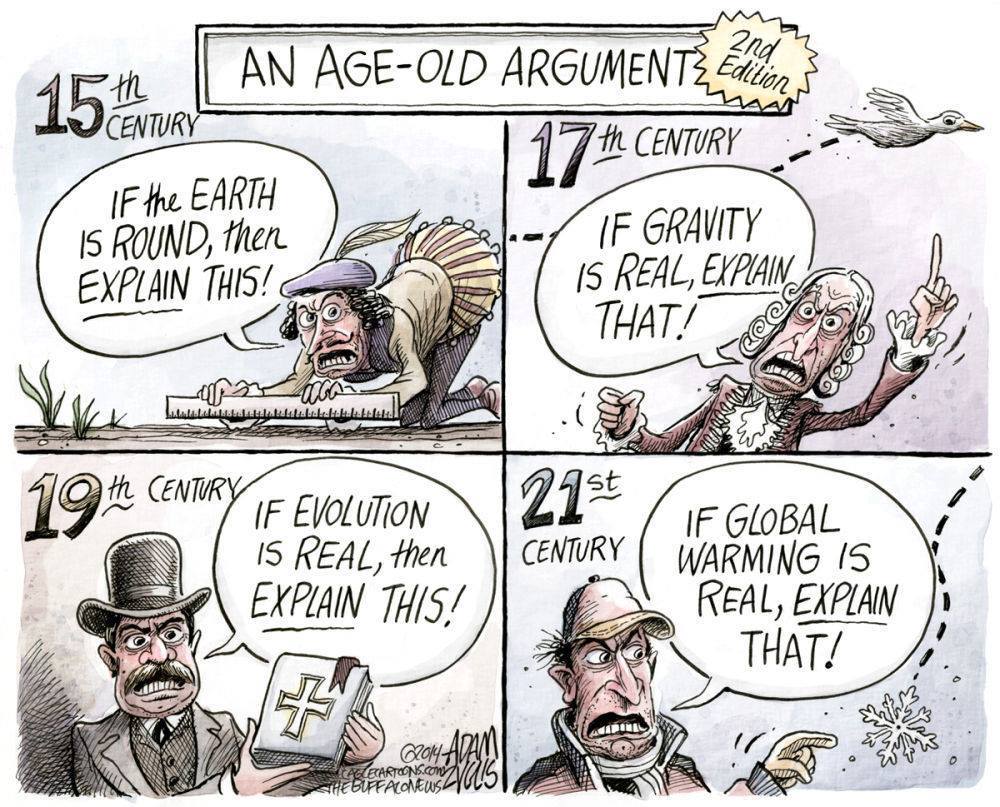This One Comic Perfectly Shuts Down Deniers of Global Warming

By:
Comics, like the one below can often strip bare superfluous arguments, and at the risk of oversimplifying complex matters, get to the heart of the issue. This April 2014 comic below, from the Buffalo News' Pulitzer Prize-winning cartoonist Adam Zyglis, deftly calls out climate change deniers for this flawed argument: "it's cold/snowing, so there can't be climate change." This argument was even employed by the chairman of the U.S. Senate's Environment and Public Works committee, Sen. James Inhofe (R-Okla.), when he held up a snowball on the floor of the Senate in an attempt to disprove climate change.
 Adam Zyglis/Buffalo News - buffalonews.com
Adam Zyglis/Buffalo News - buffalonews.com
The argument is flawed not just because, as the comic points out, the history of humankind has had its share of incorrect scientific naysayers or due to the fact that 97 percent of climate scientists agree that climate change is happening and is man-made.
It is also flawed because there's a difference between weather and climate. So while you might see snowflakes or a cold winter (like the one that just pummeled parts of the country with record snowfall), that doesn't mean that the Earth isn't getting warmer. "The difference between weather and climate is a measure of time," according to NASA. "Weather is what conditions of the atmosphere are over a short period of time, and climate is how the atmosphere 'behaves' over relatively long periods of time."
NASA gives this example:
"In most places, weather can change from minute-to-minute, hour-to-hour, day-to-day, and season-to-season. Climate, however, is the average of weather over time and space. An easy way to remember the difference is that climate is what you expect, like a very hot summer, and weather is what you get, like a hot day with pop-up thunderstorms."
Neil deGrasse Tyson also explained the difference between weather and climate in "Cosmos: A Spacetime Odyssey":
Though weather is not the same thing as climate, scientists believe that man-made, rising global temperatures may be affecting the changes we see in our weather. "Rising global average temperature is associated with widespread changes in weather patterns," the U.S. Environmental Protection Agency explains on its website. "Scientific studies indicate that extreme weather events such as heat waves and large storms are likely to become more frequent or more intense with human-induced climate change."
Some extreme weather events that may be linked to climate change include drought, storms, changes in temperature, and changes in precipitation. (NASA has mapped out effects of climate change on different areas of the country.) However, it is important to point out that given the fact that "climate" is how the atmosphere behaves over time, it may require years of observation for scientists to definitively pinpoint how climate change is directly affecting weather.
In terms of what is causing climate change, Bloomberg has a great data visualization that shows the impact of many factors -- volcanoes, the Earth's orbit, the sun, deforestation, greenhouse gasses, etc. -- on the rising global temperatures.
Beyond myth busting climate deniers, the comic above also makes a nice point about scientific advancement. Science is about asking questions, making a hypothesis, testing your hypothesis, analyzing the results, and drawing a conclusion. That's how we move forward and discover.
